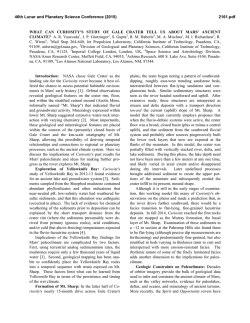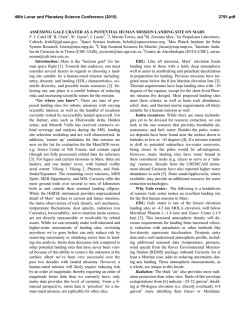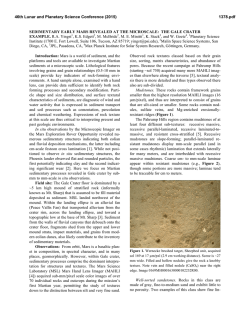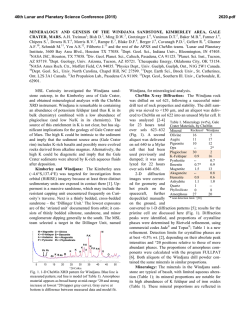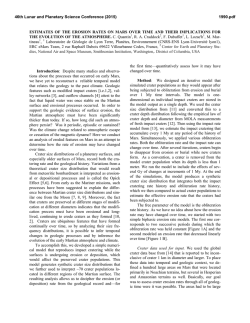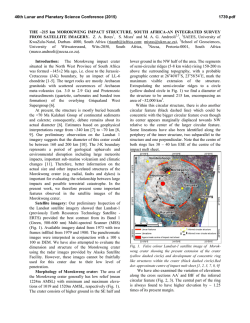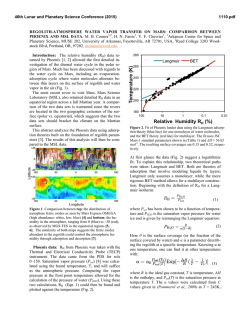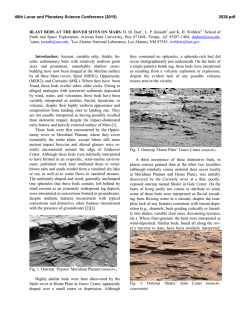
Modelling Diagenesis of Gale Crater Sedimentary Rocks
46th Lunar and Planetary Science Conference (2015) 1208.pdf MODELLING DIAGENESIS OF GALE CRATER SEDIMENTARY ROCKS: SCENARIOS TESTABLE BY THE CURIOSITY ROVER. C.S. Borlina1,2, B.L. Ehlmann2,3, 1Department of Atmospheric, Oceanic and Space Sciences, University of Michigan, Ann Arbor, MI, 2Division of Geological and Planetary Sciences, California Institute of Technology, Pasadena, CA, 3Jet Propulsion Laboratory, California Institute of Technology, Pasadena, CA. Introduction: Gale Crater, landing site of the NASA Mars Science Laboratory (MSL) mission, has a unique sedimentary stratigraphy, preserved in 5-km high Mt. Sharp. The history of its sedimentation, erosion, and secondary mineral formation preserves a record of changing geologic processes, climate and habitability on early Mars and determines the preservation potential of organics within its sedimentary rocks. We model heat flow and depths of burial to predict the temperature history of sedimentary rocks presently exposed at the surface, providing scenario-dependent predictions of diagenetic mineralogy in locations between Yellowknife Bay and upper Mt. Sharp that will be visited by the MSL Curiosity rover. Model: We consider two formation scenarios: (1) complete filling of Gale crater followed by partial removal of deposited sediments [1] or (2) building of a central deposit with morphology controlled by slope winds and only incomplete sedimentary fill of Gale crater [2]. Model inputs are described below [for complete methods, 3]. Pristine and modern topography: The pristine topographic profile was determined based on observed crater depth-diameter relationships from the MOLA dataset [4- 7]. We set the initial shape of Gale Crater to be 154 km in diameter and 5 km deep with a central peak height of 1.55 km. To have realistic slopes, we scaled the average topographic profile from Moreux crater (45E, 42N) to fit Gale's parameters. The modern average profile was used as the model endpoint. Sedimentation Scenarios: Figure 1 shows the time evolution of the considered scenarios. Scenario 1 is characterized by a complete fill of the crater to the peak of Mt. Sharp, followed by partial erosion, leaving the modern shape of Mt. Sharp as final output [1]. Sedimentation and erosion rates are computed linearly based on the defined timescales (discussed below) for erosion/sedimentation processes and necessary burial/erosion height. Scenario 2 [2] is defined by an aeolian process where the mound grew close to the center of the crater with the surrounding topography creating strong mound-flank slope winds capable of eroding the mound. Scenario 2a is defined with a constant deposition rate: the mound grows tall with a relatively constant width over time. Scenario 2b has a linearly decreasing deposition rate over time, and the mound grows wide then steepens and narrows. Timescales: Pinning surface ages based on crater counts in absolute time is challenged by the existence of different chronology models [8] yet necessary for tying burial history to models of the secular cooling of Mars. Consequently, we examine three different temporal models for the fill and exhumation of Mt. Sharp: (1) a standard model, (2) a maximum diagenesis model, and (3) a minimum diagenesis model. For (1), Mt. Sharp formation begins at 3.7 Ga, reaches 5 km in height, and is then exhumed to reach its present extent by 3.3 Ga. For (2), Gale crater and Mt. Sharp form early, 3.85 Gyr, and Mt. Sharp is exhumed late, 3.0 Gyr, thus providing a maximum for heat flow and duration of burial. For (3), Mt. Sharp forms late, 3.6 Gyr and is quickly exhumed by 3.4 Gyr. Thermal model: We use the one-dimensional steady-state heat conduction solution that describes the temperature T as a function of the depth, z, and time, t: where T0 is mean surface temperature, q(t) is heat flow as a function of time, k is thermal conductivity, ρ is density and H(t) crustal heat production as a function of time. We define ρ = 2500 kg/m3 and k = 2 W/m°C, values typical for average sedimentary rocks [9]. We examine two possibilities for early Mars mean surface temperature: T0 = 0°C and T0 = -50°C. The first presumes a warmer early Mars where temperatures rou- Figure 1: Temporal evolution of Mt. Sharp under different scenarios. The dark red line is the model endpoint. 46th Lunar and Planetary Science Conference (2015) 1208.pdf in situ unless driven by salty brines. Scenario 2a implies that swelling clays like smectites (if formed in subzero temperatures or by another process) should be the dominant clay from Yellowknife Bay and Mt. Sharp. Scenario 2b predicts liquid water at Mt. Sharp that could facilitate diagenetic transitions, though temperatures above 40ºC are not reached. Under Scenario 2b, at Yellowknife Bay the 0ºC threshold is not reached, and only freezing point-depressed brines are perFigure 2: (a) shows MSL’s traverse. (b) and (c) show the maximum tempera- mitted. ture expecienced in the past by sedimentary rocks along MSL’s traverse. For warm early Mars (T0=0⁰C), liquid water that might tinely exceed the melting point of water ice during cause alteration and diagenesis would be available large portions of the Martian year; the latter represents everywhere between Yellowknife Bay and Mt. Sharp modern-day average equatorial temperature. Finally, under all scenarios. Maximum temperatures greater q(t) and H(t) were estimated by curve-fitting geophysithan 100ºC occur at both Yellowknife Bay and Mt cal models for the evolution of heat flow [10] and crusSharp i n scenario 1, strongly favoring transformation tal heat production [11], respectively, through time. of smectites to illites or chlorites. In both Scenarios 2a MSL’s traverse: In order to locate MSL traverse and 2b, temperatures above 40ºC are reached at Mt. locations (Fig. 2a), we compute the ratio between the Sharp, while only in Scenario 2b is this threshold exdistance of the closest rim to Yellowknife Bay and the ceeded at Yellowknife Bay. distance of the rim to the base of Mt. Sharp. This is Conclusions: Mineralogical predictions for locanecessary because different models output mounds of tions close to Yellowknife Bay vary with the choice of different widths, and proper location of the rover relaa cold or warm early Mars and the Mt. Sharp sedimentive to the mound is crucial for computation of overtation scenario. For (1), temperatures experienced by burden rates. Yellowknife Bay is at 0.93 of the dissediments should decrease monotonically over the tance between the closest rim and the foothill of the traverse and up Mt. Sharp stratigraphy, whereas for (2) output mound. The unconformity is at a point ~1000 m maximum temperatures are reached in the lower units higher than Yellowknife Bay. This range represents of Mt. Sharp and thereafter decline or hold roughly MSL’s future traverse range. constant. Under partial fill scenarios, evidence of diaResults: In Scenario 1, with the time period equalgenesis at higher temperatures is expected as MSL ly split into an interval of net erosion followed by inmoves towards Mt. Sharp, with peak temperatures terval of net deposition, average rates of erosion and reached prior to the unconformity. Comparing our predeposition are 6-27 µm/yr and 8-34 µm/yr, respectivedictions with future MSL results on secondary mineral ly. In Scenario 2a average erosion rates fall between 5assemblages, their spatial variation as a function of 21 µm/yr, while average deposition rates range from 5location on the traverse, and age of any authigenic 21 µm/yr. In Scenario 2b average erosion rates are 7phases will constrain the timing and timescale of Mt. 29 µm/yr while deposition rates range from 8-35 Sharp formation, paleosurface temperature, the availaµm/yr. These rates moderately exceed estimated erobility and setting of liquid water on early Mars, and the sion rates elsewhere on early Mars, 0.7-10 µm/yr, but organic preservation potential of these deposits. are at the lower end of erosion rates from Earth, 2Acknowledgements: Thanks to E. Kite for sharing his code to 100µm/yr [12]. create slope-wind elevation profiles, the Caltech SURF program for For a cold early Mars (T0=-50⁰C), Scenario 1 leads the summer internship opportunity, and the MSL participating sciento conditions where water would be liquid and, if water tist program for partial support. References: [1] Malin & Edgett (2000) Science, 290 [2] Kite et were present, smectite would be transformed to illite or al (2013) Geology, 41 [3] Borlina & Ehlmann, submitted, JGR [4] chlorite everywhere from Yellowknife to Mt. Sharp. Garvin et al (2003) 6th Mars Science Conf [5] Boyce & Garbeil Maximum temperatures reached are ~100ºC and ~70ºC (2007) GRL 34 [6] Robbins & Hynek (2012), JGR, 117 [7] Kalynn at Yellowknife Bay and Mt. Sharp, respectively (Fig. et al (2013) GRL 40 [8] Werner & Tanaka (2011) Icarus, 215, [9] Beardsmore & Cull (2001) [10] Parmentier & Zuber (2007) JGR 112 2b and 2c). Scenario 2a does not generate conditions [11] Hahn et al (2011) GRL 38 [12] Golombek et al (2006) JGR 111 above 0ºC; there would be no alteration or diagenesis
© Copyright 2026
